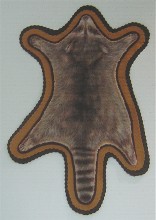 High concept shows often fall flat on their face. But not so the “Faux Show,” a hip, Post Modern confection at the Esther Klein Gallery.
High concept shows often fall flat on their face. But not so the “Faux Show,” a hip, Post Modern confection at the Esther Klein Gallery.
Since Roberta is one of the collaborators here, I will neither praise nor pan her faux review of the show, but just mention it is there, and give it high points for loopiness. On looks alone it deserves points, although I don’t think she had anything to do with the paste-up, just the contents.
The show had a lot of high spots, but Nick Paparone’s “Raccoon Rug” (top) seems like a good place to start. The name says it all. It’s made of airbrushed carpet, ultra suede and synthetic felt. The amoeba-shaped swatch barely pretends to be realistic, undercutting “Field and Stream” and “House Beautiful” in one fell swoop. The anti-trompe l’oeil used here is similar to that of Paparone’s “Everest” piece made with Jamie Dillon(see post) (top image “Racoon Rug,” airbrushed carpet, ultra suede, synthetic felt).
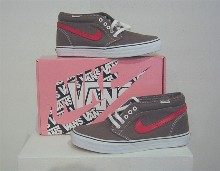 In the same vein of humor, Keith Wilkins’ “Nike id,” in which he embellishes a pair of khaki Vans and the shoebox with Nike swooshes also tickled me. Also in the same vein, M. Ho’s giant penny,”Lucky,” packaged in a cotton-lined home-made cardboard box, is worth its weight in gold. Hey, what is money anyway (image left, “Nike id,” sneakers, cardboard, spray paint)?
In the same vein of humor, Keith Wilkins’ “Nike id,” in which he embellishes a pair of khaki Vans and the shoebox with Nike swooshes also tickled me. Also in the same vein, M. Ho’s giant penny,”Lucky,” packaged in a cotton-lined home-made cardboard box, is worth its weight in gold. Hey, what is money anyway (image left, “Nike id,” sneakers, cardboard, spray paint)?
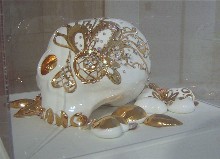 In the sparkling ceramics department, Candy Depew’s jewel-encrusted, gold-embellished skull, “Still Life with Skull” of cast bone china nails the lid on the coffin of life with glorious Mardi Gras desperation. I was thrilled to see Depew’s decorative bent go in a surprising new direction. Rain Harris’ “splendor” of prehensile ceramic froufrou and wallpaper dims Versailles’ mirror room and suggests fireworks and stars and stripes all in one grand gesture. I don’t know if this is one of the wall pieces that showed at Nexus last year, but, if not, it’s in the same family (see post) (image right, Depew’s “Still Life With Skull,” cast bone china, gold luster, swarski crystals).
In the sparkling ceramics department, Candy Depew’s jewel-encrusted, gold-embellished skull, “Still Life with Skull” of cast bone china nails the lid on the coffin of life with glorious Mardi Gras desperation. I was thrilled to see Depew’s decorative bent go in a surprising new direction. Rain Harris’ “splendor” of prehensile ceramic froufrou and wallpaper dims Versailles’ mirror room and suggests fireworks and stars and stripes all in one grand gesture. I don’t know if this is one of the wall pieces that showed at Nexus last year, but, if not, it’s in the same family (see post) (image right, Depew’s “Still Life With Skull,” cast bone china, gold luster, swarski crystals).
Old friends
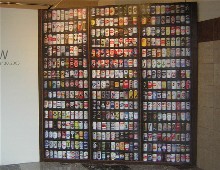 Also in the category of pieces that felt like old friends upon seeing them again, I want to mention Virgil Marti’s trompe l’oeil “Beer Can Collection,” a wallpaper rendering of beer cans lined up like books on mahogany library shelves. It still raises issues of social class and home furnishings (left, Marti’s “Beer Can Collection,” ink on paper).
Also in the category of pieces that felt like old friends upon seeing them again, I want to mention Virgil Marti’s trompe l’oeil “Beer Can Collection,” a wallpaper rendering of beer cans lined up like books on mahogany library shelves. It still raises issues of social class and home furnishings (left, Marti’s “Beer Can Collection,” ink on paper). Another old friend is Joseph Hu’s “Segafredo” ghostly coffee cup and sugar packet all made from cardboard, housepaint, tracing paper and glue. The product from his residency in Switzerland (see post) looks as great as it did at his show at Vox Populi, evoking an essence of Swiss perfection and romance.. William Lohre’s “Homeland Security,” looks better here amongst these other faux objects, its homey gun rack worth a shiver for the threat within that’s parading as protection from the threat without. This too had shown at Vox Populi (image right, Hu’s “Segafredo”).
Another old friend is Joseph Hu’s “Segafredo” ghostly coffee cup and sugar packet all made from cardboard, housepaint, tracing paper and glue. The product from his residency in Switzerland (see post) looks as great as it did at his show at Vox Populi, evoking an essence of Swiss perfection and romance.. William Lohre’s “Homeland Security,” looks better here amongst these other faux objects, its homey gun rack worth a shiver for the threat within that’s parading as protection from the threat without. This too had shown at Vox Populi (image right, Hu’s “Segafredo”).Trompes
 The rest was all new to me. For trompe l’oeil right near trompe l’oreille, Dave Delaney’s layered “Simulcast” oil portrait of a fly (a real-world faux object) on a wooden trophy placque hangs from fishing line cast off a fishing-rod-like bracket; and Chris Vecchio’s “Untitled (Sound Guantlet)” responds with 336 sound effects to motion in front of three sound sensors. From door bells to sighs to street cacophany and anyother noise you can download on line, this electronic gizmo works like a charm. The first sound made me jump, but after that, the trompe is not really a trompe. Its disembodied irrelevance of the sounds to any context turns the piece into a toy and a commentary on our faux-faux worlds of the movies, the radio and the internet. Loved playing with it, too. Besides it reminded me of how iPods replace the real world of sound with our own private sound capsule as we march down the street, oblivious (left, Delaney’s “Simulcast,” oil, wood, fishing line, fishing rod).
The rest was all new to me. For trompe l’oeil right near trompe l’oreille, Dave Delaney’s layered “Simulcast” oil portrait of a fly (a real-world faux object) on a wooden trophy placque hangs from fishing line cast off a fishing-rod-like bracket; and Chris Vecchio’s “Untitled (Sound Guantlet)” responds with 336 sound effects to motion in front of three sound sensors. From door bells to sighs to street cacophany and anyother noise you can download on line, this electronic gizmo works like a charm. The first sound made me jump, but after that, the trompe is not really a trompe. Its disembodied irrelevance of the sounds to any context turns the piece into a toy and a commentary on our faux-faux worlds of the movies, the radio and the internet. Loved playing with it, too. Besides it reminded me of how iPods replace the real world of sound with our own private sound capsule as we march down the street, oblivious (left, Delaney’s “Simulcast,” oil, wood, fishing line, fishing rod).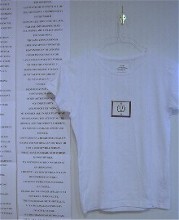 Liz Rywelski’s “Video Affirmations: A DIY Faux Conceptual Piece Made Available by G.H. Hovagimyan,” is a printout of thinking-positively slogans (kind of the antithesis of Jenny Holzer aphorisms), no video at all. I’m not even sure if the person who made this available is G.H. Hovagimyan in this context. Rywelski’s “Heart Chakra,” a tee shirt printed with an outlet on the front, not only sings the body electric as it stings the chakras into New Age submission; it is also the perfect place to plug in Paul Swenbeck’s “Red Creep,” a plastic flower/fan contraption with a wire that appears to lack a plug. In this context, I was unsure if the joke was that it didn’t work or if it was just real-life electronic or gallery failure. (And speaking of no video at all and electronic failure, would someone please fix Nadia Hironaka’s “Still Life Study #1,” which according to the guard hasn’t been working since the day after day #1? I can’t stand that I missed this) (right, detail of Rywelski’s “Video Affirmations: A DIY Faux Conceptual Piece Made Available by G.H. Hovagimyan,” ink jet print, flanked by “Heart Chakra,” white t-shirt, ink transfer print).
Liz Rywelski’s “Video Affirmations: A DIY Faux Conceptual Piece Made Available by G.H. Hovagimyan,” is a printout of thinking-positively slogans (kind of the antithesis of Jenny Holzer aphorisms), no video at all. I’m not even sure if the person who made this available is G.H. Hovagimyan in this context. Rywelski’s “Heart Chakra,” a tee shirt printed with an outlet on the front, not only sings the body electric as it stings the chakras into New Age submission; it is also the perfect place to plug in Paul Swenbeck’s “Red Creep,” a plastic flower/fan contraption with a wire that appears to lack a plug. In this context, I was unsure if the joke was that it didn’t work or if it was just real-life electronic or gallery failure. (And speaking of no video at all and electronic failure, would someone please fix Nadia Hironaka’s “Still Life Study #1,” which according to the guard hasn’t been working since the day after day #1? I can’t stand that I missed this) (right, detail of Rywelski’s “Video Affirmations: A DIY Faux Conceptual Piece Made Available by G.H. Hovagimyan,” ink jet print, flanked by “Heart Chakra,” white t-shirt, ink transfer print).Symbols for a faux universe
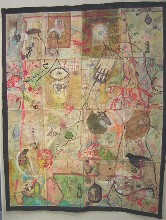 Also in the land of word and semaphore art, Merrilee Challis’ map quilt, “Alabama,” made with Chris Lawson and Andrea Paschal, had so much to look at I can barely say something coherent, other than a non-quilt with map folds about a governmental concept imposed on the land seems just right here. Loved the stitching, the drawing, the vortex of an eye, the words parading as place names, the marks parading as places, etc. etc. In contrast, Jane Irish’s dreamy pale blue gouache “Free Speech,” is the words “free speech” against a minimal backdrop, with grid and numbers and a few unreadable glyphs that suggest bits, bytes and other internet food for thought (left, “Alabama,” mixed media, by Challiss, with Lawson and Paschal).
Also in the land of word and semaphore art, Merrilee Challis’ map quilt, “Alabama,” made with Chris Lawson and Andrea Paschal, had so much to look at I can barely say something coherent, other than a non-quilt with map folds about a governmental concept imposed on the land seems just right here. Loved the stitching, the drawing, the vortex of an eye, the words parading as place names, the marks parading as places, etc. etc. In contrast, Jane Irish’s dreamy pale blue gouache “Free Speech,” is the words “free speech” against a minimal backdrop, with grid and numbers and a few unreadable glyphs that suggest bits, bytes and other internet food for thought (left, “Alabama,” mixed media, by Challiss, with Lawson and Paschal).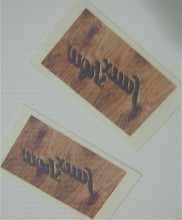 Some pieces whose faux-ness eluded me included Steven Wise’s two little number paintings, Charles Hobbs’ swell wooden snake, “Liss-en,” and Thom Lessner’s “Van Halen” ink drawing, although the latter does bring to mind the faux relationship implied by fandom, and in the world of fandom, Lessner has proved himself again and again a super-fan, a virtual model citizen of the realm. I certainly wasn’t fooled by the fauxness of my take-home fake tattoos, wood-patterned contact paper for the skin–hello Richard Artschwager (right). So who made these ? Are they a faux work of art(image right)?
Some pieces whose faux-ness eluded me included Steven Wise’s two little number paintings, Charles Hobbs’ swell wooden snake, “Liss-en,” and Thom Lessner’s “Van Halen” ink drawing, although the latter does bring to mind the faux relationship implied by fandom, and in the world of fandom, Lessner has proved himself again and again a super-fan, a virtual model citizen of the realm. I certainly wasn’t fooled by the fauxness of my take-home fake tattoos, wood-patterned contact paper for the skin–hello Richard Artschwager (right). So who made these ? Are they a faux work of art(image right)?
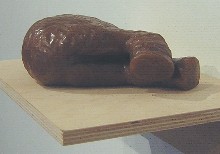 Clint Takeda’s “Elephant Butt (without tail)” is the most poignant piece in the show, a small, hollowed rendering in wax of the rear portion of a great beast on its side, its legs delicately draped at the ankle. Of course it’s man parading as a beast, or maybe just the identity of man and beast. This piece alone is worth the trip to University City (left, Takeda’s “Elephant Butt (without tail),” wax).
Clint Takeda’s “Elephant Butt (without tail)” is the most poignant piece in the show, a small, hollowed rendering in wax of the rear portion of a great beast on its side, its legs delicately draped at the ankle. Of course it’s man parading as a beast, or maybe just the identity of man and beast. This piece alone is worth the trip to University City (left, Takeda’s “Elephant Butt (without tail),” wax).
[04/21/06 addition from Libby: Got an email from G.H. Hovagimyan a couple of days ago commenting on this post. I thought you’d like this information explaining something about Liz Rywelski’s contribution to the show.]
Email from G.H. Hovagimyan:
On November 17th, 2005 you wrote:
Liz Rywelski’s “Video Affirmations: A DIY Faux Conceptual Piece Made Available by G.H. Hovagimyan,” is a printout of thinking-positively slogans (kind of the antithesis of Jenny Holzer aphorisms), no video at all. I’m not even sure if the person who made this available is G.H. Hovagimyan in this context.
Yes Liz contacted me to get permission to print out the work video affirmations. The original piece is online at here. There are two parts to the piece 1. The text slogans and 2. Clown Piece (videos) here.
[Libby: I didn’t include the text slogan link because the page was defunct and took me to the Clown Piece videos page]
The piece is fairly complex. It has an online component and a real world component. The DIY and the videos extend the piece into a variable media arena. The original piece was done in 1994. The whole site is a proposal for a Museum/special projects room. I also have a boxed set of the original design boards. This refers to Duchamp’s Green box which you know is in the Philadelphia Museum.
Since I did the piece I periodically get requests from people from around the world to print out the work. I’d say that the work was the first DIY piece on the internet.
–G.H. Hovagimyan









